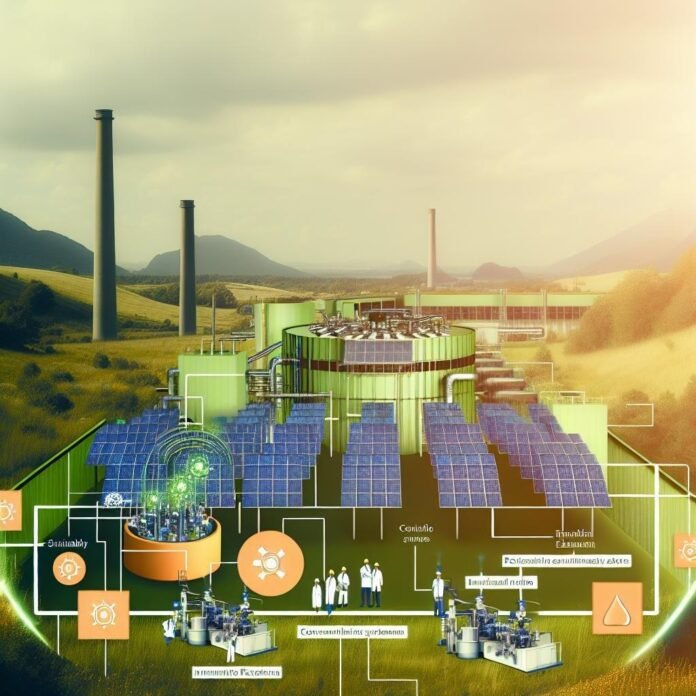: A Sustainable Revolution in Manufacturing
in an era marked by rapid technological advancements and an increasing urgency to address climate change, industries are seeking innovative solutions to enhance efficiency while reducing their carbon footprints. One promising frontier in this quest is solar thermal energy—a versatile and sustainable energy source that harnesses the sun’s heat for various industrial applications. From powering processes like drying, heating, and steam generation to driving notable operational cost savings, the potential of solar thermal energy in industrial settings is vast and largely untapped. In this article, we will explore how industries can leverage solar thermal technology to not only improve their energy efficiency but also contribute to a greener future. Join us as we delve into the advantages, challenges, and real-world applications of solar thermal energy, and discover how this renewable resource can revolutionize the way we think about industrial power and productivity.
Table of contents
- Understanding Solar Thermal Energy and Its Industrial Applications
- Innovative Technologies for Enhanced Solar Thermal Efficiency
- Strategies for Integrating Solar Thermal Systems in Manufacturing Processes
- Measuring the Economic Impact of Solar Thermal Energy in Industry
- In summary
Understanding Solar Thermal Energy and Its Industrial Applications
solar thermal energy refers to the harnessing of the sun’s heat for practical use, particularly in industrial settings were energy efficiency is paramount. This technology captures thermal energy through solar collectors, which can then be utilized for a variety of processes, such as water heating, steam generation, and even electricity production. Industries like food processing, chemical manufacturing, and textile production stand to gain substantially from adopting solar thermal systems, reducing their reliance on fossil fuels and lowering operational costs. The integration of such systems not only contributes to sustainability but also enhances energy self-sufficiency, allowing businesses to mitigate the volatility of energy prices.
The applications of solar thermal energy in industrial contexts can be numerous and diverse. Some of the most notable include:
- Process Heat Generation: Used in various manufacturing processes, such as pasteurization and drying.
- Space Heating: Efficiently heats large facilities, reducing energy consumption.
- Combined Heat and Power (CHP): Utilizes waste heat for additional energy production.
- Desalination: Provides thermal energy for converting seawater into freshwater.
To paint a clearer picture, the following table summarizes key industries and their respective solar thermal applications:
| Industry | Request | Benefits |
|---|---|---|
| Food Processing | Pasteurization | Improved sustainability |
| Chemical Manufacturing | Steam Generation | Reduced operational costs |
| Textiles | Drying Processes | Increased efficiency |
| Pharmaceuticals | Heating Solutions | Enhanced product quality |
Innovative Technologies for Enhanced Solar Thermal Efficiency
Advancements in technology are revolutionizing the field of solar thermal energy, making it more efficient and accessible for various industrial applications. One such breakthrough is the advancement of high-temperature solar collectors that use advanced materials to absorb and convert sunlight into thermal energy at elevated temperatures. These collectors not only increase the efficiency of heat transfer but also open the door for processes requiring higher heat than conventional systems can provide.Other innovative solutions include thermoelectric generators, which can convert waste heat from industrial processes into electrical energy, significantly reducing overall energy consumption and improving the sustainability of operations.
Moreover, smart tracking systems are transforming the way solar thermal energy is harnessed.These systems utilize complex algorithms and sensors to adjust the angles of solar panels throughout the day, optimizing sunlight capture and enhancing overall performance. The integration of energy storage solutions, such as phase change materials (PCMs), allows industries to store thermal energy for use during non-sunny periods, ensuring a continuous supply and improving operational resilience. The combination of these technologies not only maximizes the efficiency of solar thermal systems but also leads to notable cost savings and a reduced carbon footprint for industries embracing renewable energy.
Strategies for Integrating Solar Thermal Systems in Manufacturing Processes
Incorporating solar thermal energy into manufacturing processes can significantly enhance energy efficiency and reduce operational costs. Conducting an initial energy audit is crucial, allowing industries to identify specific heat requirements and potential areas for integration. The following strategies can be employed to effectively utilize solar thermal systems:
- Retrofit existing boilers with solar thermal collectors to preheat water, thereby lowering fuel consumption.
- Integrate solar thermal heating into processes requiring steam, such as food processing or chemical manufacturing.
- Utilize thermal storage tanks to store solar heat, providing consistent energy supply even during non-sunny hours.
- Combine solar thermal with other renewable technologies, such as photovoltaic systems, to create a hybrid energy approach that maximizes efficiency.
Furthermore, partnerships with local solar energy providers can facilitate the installation and maintenance of solar thermal systems, making it easier for manufacturers to transition to renewable energy sources. Consider implementing the following actionable steps:
| Action Step | Description |
|---|---|
| Conduct Feasibility Studies | Assess potential savings and ROI from solar thermal system integration. |
| Employee Training | equip staff with knowledge on operating solar thermal systems effectively. |
| Regulatory compliance | Ensure adherence to local regulations and incentives related to renewable energy. |
measuring the Economic Impact of Solar Thermal Energy in Industry
presents a unique opportunity to assess both immediate savings and long-term benefits. By utilizing solar thermal systems, industries can significantly reduce their reliance on fossil fuels, leading to ample cost reductions. Key factors to consider include:
- Operational Savings: lower energy costs directly influence profit margins.
- Incentives and Subsidies: Government programs can offset initial investment costs.
- Increased Productivity: Reliable heat delivery enhances operational efficiency.
- Environmental Compliance: Adopting renewable energy can minimize compliance costs.
To quantify these benefits, businesses often conduct a cost-benefit analysis that examines both direct and indirect impacts. The table below illustrates a basic breakdown of potential financial gains from implementing solar thermal energy:
| Category | Annual Savings ($) | Investment Payback Period (years) |
|---|---|---|
| Energy Costs | 15,000 | 3 |
| Maintenance | 2,500 | 3.5 |
| Tax Incentives | 5,000 | N/A |
| Total | 22,500 | 3 |
This comprehensive approach not only reveals potential fiscal prudence but also emphasizes the broader societal benefits of transitioning to renewable energy sources. By embracing solar thermal technology, industries can pave the way towards a more sustainable and economically viable future.
In Summary
harnessing solar thermal energy presents a remarkable opportunity for industries to not only enhance their operational efficiency but also to make a meaningful contribution to sustainability. by leveraging this abundant and renewable resource, businesses can significantly reduce their energy costs, lower their carbon footprints, and transition towards greener practices. As technology evolves and more industries recognize the long-term benefits of solar thermal solutions, we can anticipate a future where solar energy is a standard component of industrial operations.
As we move forward,its crucial for industry leaders to stay informed about the latest advancements in solar thermal technology and consider how these innovations can be integrated into their processes.Whether through retrofitting existing systems or investing in new installations, the potential for increased efficiency and environmental stewardship is vast.
embracing solar thermal energy is not merely an option; it is an essential step toward sustainable industrial practices. By making this shift, companies can not only ensure their competitiveness in an increasingly eco-conscious market but also play a pivotal role in shaping a more sustainable future. Now is the time to act—let’s harness the power of the sun to fuel our industries and protect our planet for generations to come.

